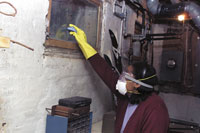Mold and Moisture
A Brief Guide to Mold, Moisture, and Your Home
What to Wear When Cleaning Moldy Areas
| Table of Contents |
| Mold Basics |
| Mold Cleanup |
| Mold Cleanup Guidelines |
| What to Wear When Cleaning Moldy Areas |
| Moisture and Mold Prevention and Control Tips |
| Hidden Mold |
PDF Version (20 pp., 1.4 M, about PDF)
Una Breve Guía para el Moho, la Humedad y su Hogar (PDF) (11 pp., 1.28 M, disponible en PDF). Documento de la agencia EPA número 402-K-03-008, reimprimido el 2010 de mayo.
It is important to take precautions to LIMIT YOUR EXPOSURE to mold and mold spores.
- Avoid breathing in mold or mold spores. In order to limit your exposure to airborne mold, you may want to wear an N-95 respirator, available at many hardware stores and from companies that advertise on the Internet. (They cost about $12 to $25.) Some N-95 respirators resemble a paper dust mask with a nozzle on the front, others are made primarily of plastic or rubber and have removable cartridges that trap most of the mold spores from entering. In order to be effective, the respirator or mask must fit properly, so carefully follow the instructions supplied with the respirator. Please note that the Occupational Safety and Health Administration (OSHA) requires that respirators fit properly (fit testing) when used in an occupational setting; consult OSHA for more information (800-321-OSHA or www.osha.gov).
- Wear gloves. Long gloves that extend to the middle of the forearm are recommended. When working with water and a mild detergent, ordinary household rubber gloves may be used. If you are using a disinfectant, a biocide such as chlorine bleach, or a strong cleaning solution, you should select gloves made from natural rubber, neoprene, nitrile, polyurethane, or PVC (see Cleanup and Biocides). Avoid touching mold or moldy items with your bare hands.
- Wear goggles. Goggles that do not have ventilation holes are recommended. Avoid getting mold or mold spores in your eyes.
How Do I Know When the Remediation or Cleanup is Finished?
You must have completely fixed the water or moisture problem before the cleanup or remediation can be considered finished.
- You should have completed mold removal. Visible mold and moldy odors should not be present. Please note that mold may cause staining and
cosmetic damage.
- You should have revisited the site(s) shortly after cleanup and it should show no signs of water damage or mold growth.
- People should have been able to occupy or re-occupy the area without health complaints or physical symptoms.
- Ultimately, this is a judgment call; there is no easy answer. If you have concerns or questions consult our Frequently Asked Questions database and ask a question if you don't find what you need.
Additional Resource
The publication, "Mold Remediation in Schools and Commercial Buildings", is available in HTML and PDF (56 pp., 1.6 M) [EPA 402-K-01-001, September 2008]


